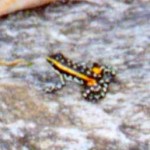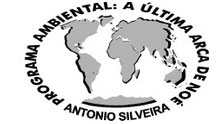Os espetaculares sapos-flechas-de-veneno
Os espetaculares sapos-flechas-de-veneno
Família Dendrobatidae

Introdução
A família dendrobatidae é formada por 8 gêneros e cerca de 192 espécies, entre as quais estão sem sombra de dúvidas alguns dos mais espetaculares animais da face da terra: são os famosos sapinhos-ponta-de-flexa, conhecidos mundialmente como Poison Dart Frogs.
Os Poison Dart Frogs são animais de cores vivas como vermelho, amarelo, azul e verde que lhes dão grande beleza. Pertencem ao gênero dendrobates e phyllobates, principalmente e são muito procurados por criadores de todo o mundo.
O nome popular destes animais origina-se do costume dos índios embera, da Colômbia, que utilizam o veneno de algumas das espécies como o Phyllobates terribilis para envenenar os dardos de suas zarabatanas para caçar.
O veneno desenvolvido por estas espécies é fortíssimo e pode causar a morte de uma pessoa que o manipular com as mãos sem a proteção de luvas e sem os devidos cuidados. Acredita-se que o veneno vem das formigas que eles comem, o qual é incorporado nos tecidos de sua pele.
Habitat e alimentação:
Os dendrobates são animais que vivem, na quase totalidade das espécies, no chão das florestas tropicais da América Central e do Sul. Gostam da umidade do ambiente florestal, onde se alimentam principalmente de formigas.
Comportamento reprodução:
Colocam os ovos no chão da floresta, normalmente embaixo de folhas, onde um dos pais toma conta até que eles eclodam. Em seguida o macho ou a fêmea levam os girinos em suas costas até uma cavidade de alguma árvore ou até uma poça d’água em bromélias, às vezes um a um (Dendrobates pumillo ) como tivemos a oportunidade de registrar na Costa Rica. O desenvolvimento se dá no novo ambiente aquático.
Vocalização:
Normalmente os dendrobates vocalizam com trinados emitidos repetidamente por muitos minutos, com espaços de tempo bem curtos e com freqüência monótona; exemplo: ti, ti, ti, ti, ti, ti …
ESPÉCIES QUE OCORREM NO BRASIL *
Família Dendrobatidae
Adelphobates castaneoticus (Caldwell & Myers, 1990)
Adelphobates galactonotus (Steindachner, 1864)
Adelphobates quinquevittatus (Steindachner, 1864)
Ameeraga berohoka Vaz-Silva & Maciel, 2011
Ameerega braccata (Steindachner, 1864)
Ameerega flavopicta (A. Lutz, 1925)
Ameerega hahneli (Boulenger, 1884 “1883″)
Ameerega macero (Rodriguez & Myers, 1993)
Ameerega petersi (Silverstone, 1976)
Ameerega picta (Bibron in Tschudi, 1838)
Ameerega pulchripecta (Silverstone, 1976)
Ameerega trivittata (Spix, 1824)
Dendrobates leucomelas Steindachner, 1864
Dendrobates tinctorius (Cuvier, 1797)
Hyloxalus peruvianus (Melin, 1941)
Hyloxalus chlorocraspedus (Caldwell, 2005)
Ranitomeya amazonica (Schulte, 1999)
Ranitomeya cyanovittata Perez-Peña, Chavez, Twomey & Brown, 2010
Ranitomeya defleri Twomey & Brown, 2009
Ranitomeya flavovittata (Schulte, 1999)
Ranitomeya sirensis (Aichinger, 1991)
Ranitomeya toraro Brown, Caldwell, Twomey, Melo-Sampaio & Souza, 2011
Ranitomeya uakarii Brown, Schulte & Summers, 2006
Ranitomeya vanzolinii (Myers, 1982)
Ranitomeya variabilis (Zimmermann & Zimmermann, 1988)
Ranitomeya yavaricola Perez-Peña, Chavez, Twomey & Brown, 2010
Obs: relação SBH. 2005. Lista de espécies de anfíbios do Brasil. Sociedade Brasileira de Herpetologia (SBH). Disponível em:http://www.sbherpetologia.org.br/?page_id=644
————-
Bibliografia
– AICHINGER, M. 1991. Tadpole transport in relation to rainfall, fecundity and body size in five species of poison-dart frogs from Amazonian Peru. Amphibia-Reptilia 12:49-55.
– BOKERMANN, W.C.A. 1958. Sobre una nueva specie de Dendrobates del norte del Brasil (Amphibia, Salientia, Brachycephalidae). Neotropica, La Plata, 4(15):73-76 (1 dez 1958 ).
– BOKERMANN, W.C.A. 1967. Novas espécies de Phyllobates do leste e sudeste brasileiro. (Anura, Dendrobatidae) Rev. Bras. Biologia, rio de Janeiro 27(4):349-53 ( dez 1967 ).
– BOKERMANN, W.C.A. 1975. Uma nova espécie de Colosthetus do Brasil Central (Anura, Dendrobatidae). Iheringia (Zoologia) 46:13-19 (30 jun 75).
– BUNNEL, P. 1973. Vocalizations in the territorial behavior of frog Dendrobates pumilio. Copeia, 1973(2): 277-284.
– CALDWELL, J. P. 1993. Brazil nut fruit capsules as phytotelmata: interactions among anuran and insect larvae. Can. J. Zool. 71:1193-1201.
– CALDWELL, J. P. 1996. The evolution pf myrmecophagy and its correlates in poison frogs (Family Dendrobatidae). Journal Zool. Lond. 240:75-101.
– CALDWELL, J. P. 1997. Pair bonding in spotted poison frogs. Nature 385:211.
– CALDWELL, J. P. 1998. Cannibalistic interactions resulting from indiscriminate predatory behavior in tadpoles of poison frogs (Anura: Dendrobatidae). Biotropica 30:92-103.
– CALDWELL, J. P. & OLIVEIRA, V. R. L. 1999. Determinants of biparental care in the spotted poison frog, Dendrobates vanzolinii (Anura: Dendrobatidae). Copeia 1999:565-575.
– CRUMP, M.L. 1972. Territoriality and mating behavior in Dendrobates granuliferus ( Anura: Dendrobatidae ). Herpetologica, 28:195-198.
– DALY, J. W.; SECUNDA, S. I.; GARRAFFO, H. M.; SPANDE, T. F.; WISNIESKI, A. & COVER, J. F. 1994. An uptake system for dietary alkaloids in poison frogs (Dendrobatidae). Toxicon 32:657-663.
– DIXON, J.R. & C. RIVERO-BLANCO. 1985. A new dendrobatid frog (Colostethus) from Venezuela with notes on its natural history and that of related species. Journal of Herpetology, 19(2):177-184.
– DONNELLY, M.A. 1989a. Reproductive phenology and age structure of Dendrobates pumilio in northeastern Costa Rica. Journal of Herpetology, 23(4):362-367.
– DONNELLY, M.A. 1989b. Effects of reproductive resource supplementation on space-use patterns in Dendrobates pumilio. Oecologia, 81:212-218.
– DUELLMAN, W.E. 1966. Agressive behavior in dendrobatid frogs. Herpetologica. 22:217-221.
– DUELLMAN, W.E. & TRUEB, L. 1986. Biology of amphibians. McGraw Hill Book Co., New York. 670 pp.
– DURANT, P.& J.W.DOLE. 1975/ Aggressive behavior in Colostethus (=Prostherapis ) collaris ( anura: Dendrobatidae ). Herpetologica, 31(1):23-26.
– EDWARDS, S.R. 1974. Taxonomic notes on south American dendrobatid frogs of genus Colestehus. Mus. Nat. Hist.Univ. Kansas, 30:1-14.
– GOODMAN, D. E. 1971. Territorial bahavior in a neotropical frog, Dendrobates granuliferus. Copeia. 1971:365-379.
– HADDAD, C.F.B. 1989.Territorialidade em anfíbios anuros. VII Encontro Anual de Etologia, p.123-133.
– HADDAD, C. F. B. & MARTINS, M. Notes on four species of frogs related to epipedobates pictus. Her[etologica 50: 282-295. Palavras-Chave: TAXONOMIA; EPIPEDOBATES; ANFIBIO
– JAEGER, R.G., J.P. HAILMAN and L.S. JAEGER. Bimodal dial activity of a panamanian dendrobatid frog. Colostethus nubicula, in relation to ligth, Herpetologica 32:77-81.
– JUNCÁ, F. A. 1998. Reproductive biology of Colostethus stepheni and Colostethus marchesianus (Dendrobatidae), with the description of a new anuran mating behavior. Herpetologica 54:377-387.
– JUNC°, F.S. 1990. Uma análise experimental sobre a importância do cuidade parental em Colostethus stepheni ( Anura: Dendrobatidae ). Resumos do II Congresso Latinoamericano de Herpetolofica, p.67.
– JUNC°, F.A.R. Altig and C.GASCON, in press.Breeding biology of Colostethus stephani: a dendrobatid with a non-transported nidicolous tadpole. Copeia.
– JUNC°, F.A. 1994. Ecologia e biologia reprodutiva de suas espécies simpátricas de Colostethus, (Anura, Dendrobatidae) da região de Manaus Amazônia Central. 84 pp. ilustr. Dissertação de Mestrado- USP (15 mar 94).
– MARTINS, M. & SAZIMA, Dendrobatideos. Cores e venenos. Ciencia Hoje, 9(53):34-38, 1989.
– MARTINS, M 1990. Nova espécie de Colostethus da Amazônia Central ( Amphibia: Dendrobatidae ). Rev. Bras. Brasil. Biol., 49(4):1009-1012.
– MAYERS, C.W. Spotted poison frogs: descriptions of three new dendrobatidis from nistem amazonia, and reservection of lost species from “ Chiriqui “. Am. Mus. Novet.2721:1-23,1982.
– MICHAUD, E. J. & DIXON, J. R. 1989. Prey items of 20 species of the Neotropical colubrid snake genus Liophis. Herpetol. Rev. 20:39-41.
– MYERS, C. W.; DALY, J. W. & MALKIN, B. 1978. A dangerously toxic new frog (Phyllobates) used by Embera Indians of western Colombia, with discussion of blowgun fabrication and dart poisoning. Bull. Am. Mus. Nat. Hist. 161(2):307-366.
– POUGH, F.H. and T.L. TAIGEN. 1990. Metabolic correlates of the foraging and social behavior of dart-poison frogs. Anim. Behav., 39(1):145-155.
– ROITHMAIR, M.E. 1992. Territoriality and male matinf success in dart-poison frog, Epipedobates femoralis ( Dendrobatidae, Anura ). Ethology, 92:331-343.
– SAVAGE, J.M. 1968. The dendrobatid frogs of Central America. Copeia. 1968 (4): 745-776.
– SILVESTONE, P.A. 1973. Observations on behavior and ecology of a colombian poison-arrow frog, the KôKoé-Pá ( Dendrobates histrionicus Berthold ). Herpetologica, 29(4):295-301.
– SILVESTONE, P.A. 1975. A revision of the poison-arrow frogs of the genus Dendrobates Wagler. Nat. Hist. Mus. Los Angeles Co. Sci. Bull., ( 21 ):1-55.
– SILVERSTONE, P.A. A revision of the poison arrow frog of the genus Dendrobatis Wagler. Nat. Hist. Mus. Los. Angeles Co. sci. bull, 21:1-55,1975.
– SUMMERS, K. 1989. Sexual selection and intra-female competition in the green poison-dart frog. Dendrobates auratus. Anim. Behav., 37(5):797-805.
– SUMMERS, K. 1990. Parental care and the cost of polygyny in green dart-poison frog. Behav. Ecol. Sociobiol., 27:307-313.
– WELLS, K.D. 1980a. A social behavior and communication of dendrobatid frog ( Colostethus trinitalis ). Herpetologica, 36(2):189-199.
– WELLS, K.D. 1980b.Behavioral escology and social organization of a dendrobatid frog ( Colosteteus ingrinalis ). Behav. Ecol. Sociobiol.6:199-209.
– WEYGOLDT, P. 1986. Evolution of parental care in dart poison frogs ( Amphibia: Anura: Dendrobatidae ). Z.Zool. Syst. Evolut. forsch. 25:51-67.
– ZIMMERMANN, E. 1990. Behavioral signals and reproduction modes in the neotropical frogs family Dendrobatidae. In W. Hanke ( hrsg ). Biology and Physiology of Amphibians, 62-73 pp. Gustav Fischer Verlag, Stuttgart – New York.
————-
Sites
Sociedade Brasileira de Herpetologia
Amphibian Species of the World-American Museum of Natural History- Department of Herpetology
———————–
Antonio Silveira: Last update: 10/12/2013.




